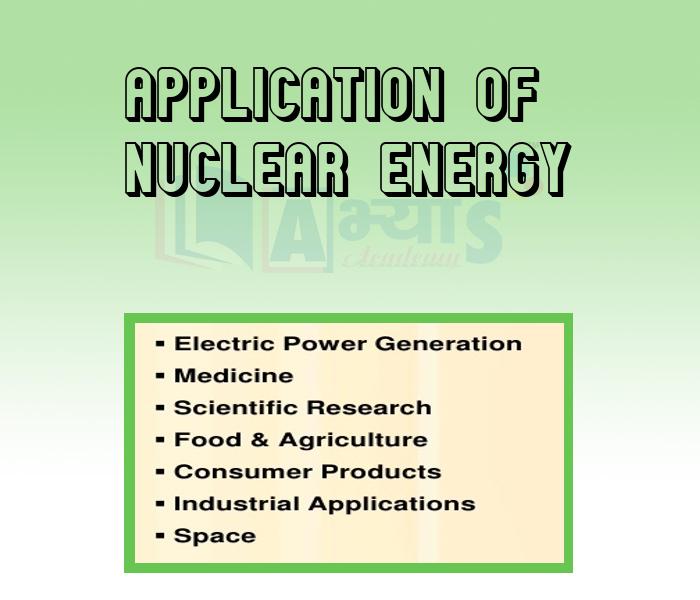Application Of Nuclear Energy


Application Of Nuclear Energy
Applications of Nuclear Energy:
Peaceful Applications: Nuclear reactors fuelled by uranium 235 are used
(i) to generate electricity.
(ii to propel ships.
(iii) to desalt ocean water (reactor-produced heat boils the water).
(iv) to produce the fissionable materials - plutonium 239 and uranium 233
(v) to produce radioisotopes.
(vi) for medical imaging, which has many uses in science, medicine and industry.
Nuclear Reactors: A nuclear reactor is a device in which a controlled, self-sustaining fission or fusion reaction is produced.
Radioactive Waste: A serious problem associated with the use of atomic energy is the handling treatment, and disposal of the radioactive waste products – liquid, solid, and gaseous- it creates. These wastes, such as liquids used in the chemical processing of reactor fuels or as coolants, spent (used-up) solid fuel elements, and gases used as reactor coolants, contain dangerous radioactive materials.
Several methods for the long-term disposal of highly radioactive wastes have been developed and studied. The most widely accepted plan consists of binging the wastes in a glass like or ceramic substance that is very resistant to corrosion. This waste material would be placed deep underground in very stable geological formations where it would remain undisturbed. Long-range plans of several countries include disposal of highly radioactive wastes in granite formations underground or under the sea floor, in frozen clay, and in salt domes.
Nuclear Weapons: Explosive devices that utilise the fission process were originally called atmoic weapons, while those that depend on fusion were known as hydrogen weapons or thermonuclear weapons. These terms are still used occasionally, but the term nuclear weapons, which designates both fission and fusion as weapons, is used more frequently.
Effect: The explosive power, or yield, of a nuclear weapon is measured by the number of ions of the explosive trinitrotoluene (TNT) it would take to produce an equivalent blast. Fission bombs are usually measured in kilotons of TNT or thousands of tons, while fusion weapons are frequently measured in megatons of TNT or millions of tons.
Students / Parents Reviews [10]
My experience with Abhyas is very good. I have learnt many things here like vedic maths and reasoning also. Teachers here first take our doubts and then there are assignments to verify our weak points.

Shivam Rana
7thAbout Abhyas metholodology the teachers are very nice and hardworking toward students.The Centre Head Mrs Anu Sethi is also a brilliant teacher.Abhyas has taught me how to overcome problems and has always taken my doubts and suppoeted me.

Shreya Shrivastava
8thOne of the best institutes to develope a child interest in studies.Provides SST and English knowledge also unlike other institutes. Teachers are co operative and friendly online tests andPPT develope practical knowledge also.

Aman Kumar Shrivastava
10thMy experience was very good with Abhyas academy. I am studying here from 6th class and I am satisfied by its results in my life. I improved a lot here ahead of school syllabus.

Ayan Ghosh
8thMy experience with Abhyas academy is very good. I did not think that my every subject coming here will be so strong. The main thing is that the online tests had made me learn here more things.

Hiya Gupta
8thAbhyas is a complete education Institute. Here extreme care is taken by teacher with the help of regular exam. Extra classes also conducted by the institute, if the student is weak.

Om Umang
10thIt has a great methodology. Students here can get analysis to their test quickly.We can learn easily through PPTs and the testing methods are good. We know that where we have to practice

Barkha Arora
10thI have spent a wonderful time in Abhyas academy. It has made my reasoning more apt, English more stronger and Maths an interesting subject for me. It has given me a habbit of self studying

Yatharthi Sharma
10thBeing a parent, I saw my daughter improvement in her studies by seeing a good result in all day to day compititive exam TMO, NSO, IEO etc and as well as studies. I have got a fruitful result from my daughter.

Prisha Gupta
8thIt was good as the experience because as we had come here we had been improved in a such envirnment created here.Extra is taught which is beneficial for future.
